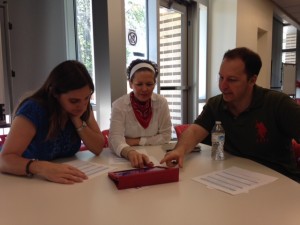On May 6, 2016, faculty teaching Spanish, German, Chinese, and French at UH came together to see first-hand how to facilitate active learning in their language classes. The demonstration was the result of a collaboration between FDIS, Hispanic Studies, and Modern and Classical Languages. The demo took place in the Active Learning Classroom (ALC), located at 1020 Cougar Place.
 Anjana Singhal, Instructional Designer in FDIS, started the session off with an introduction to the foundational principles of active learning. She cited Bonwell and Eison (1991), describing active learning as “anything that involves students in doing things and thinking about the things they are doing” (p. 5). This, she explained, means that students: do more than simply listen; engage in activities; develop skills; develop higher-order thinking; and explore their own attitudes and values related to the material being taught. Implementing active learning methodologies can improve outcomes because students then see class activities as real and relevant, sparking interest in the topic and taking ownership of their learning.
Anjana Singhal, Instructional Designer in FDIS, started the session off with an introduction to the foundational principles of active learning. She cited Bonwell and Eison (1991), describing active learning as “anything that involves students in doing things and thinking about the things they are doing” (p. 5). This, she explained, means that students: do more than simply listen; engage in activities; develop skills; develop higher-order thinking; and explore their own attitudes and values related to the material being taught. Implementing active learning methodologies can improve outcomes because students then see class activities as real and relevant, sparking interest in the topic and taking ownership of their learning.
Ms. Singhal enumerated the unique affordances of the ALC, which is equipped with flexible furniture and cutting-edge technology in order to maximize opportunities for active learning. The classroom has been in use for the past four semesters by faculty teaching in a range of disciplines, including Geology, Nutrition, Communication Sciences and Disorders, and Political Science.
After attending an Emerging Trend hosted by Ms. Singhal and Dr. Temple Northup in the ALC in the Fall semester, Dr. Edie Furniss (Director of the Language Acquisition Center) began thinking of the potential of the space for language teaching, resulting in this collaboration. During the session, Dr. Furniss spoke to the language-specific benefits of the ALC: it can encourage collaboration, enable a variety of tasks, promote learner autonomy and digital literacy, and incorporate multiple modalities to engage learners.
After this introduction, Ms. Tatiana Ferrer, doctoral student in the Hispanic Studies department and instructor of Spanish, led a demonstration of two tools for active learning: Plickers and Kahoot. Plickers combines scannable printouts with a smartphone app to take attendance or allow students to participate in polls, while Kahoot is a web-based quiz program.
The demonstration inspired a flurry of discussion and creative brainstorming in which teachers across languages shared ideas for how to best utilize these tools and ALC itself. Even those attendees who will not be teaching in the ALC next fall left the session with an understanding of the principles of active learning and new ideas for future classes.
For more information about active learning at UH, visit the ALC website: http://www.uh.edu/fdis/innovation/active-learning-classroom/alc-at-uh/
Or, read more about active learning on Instruction @ UH: http://www.instruction.uh.edu/tags/active-learning/




